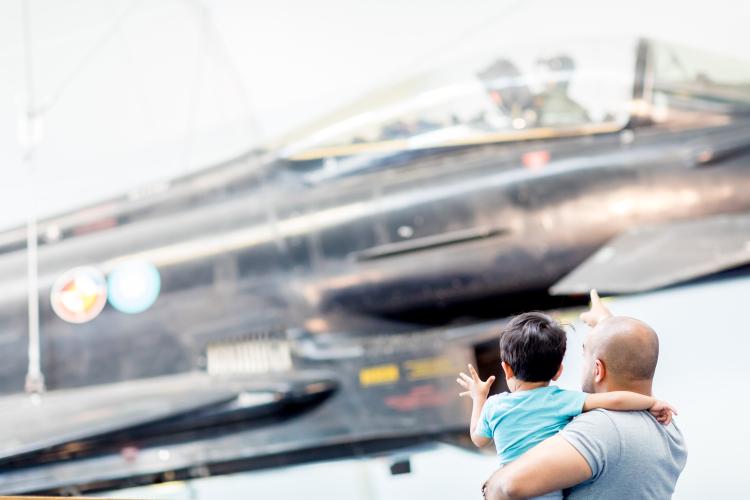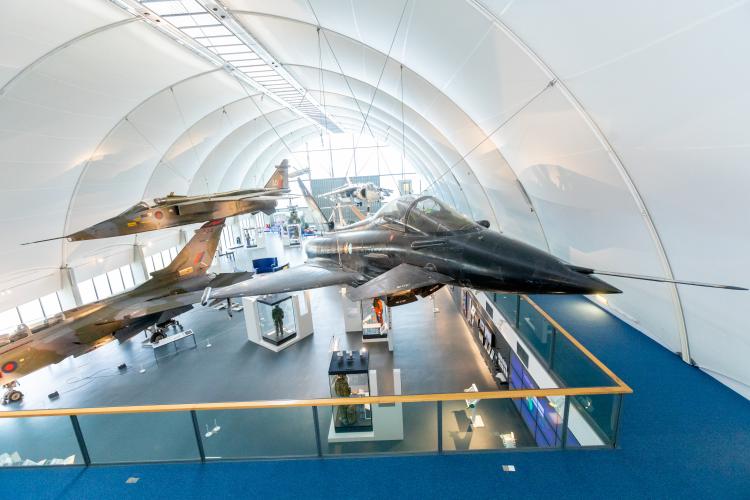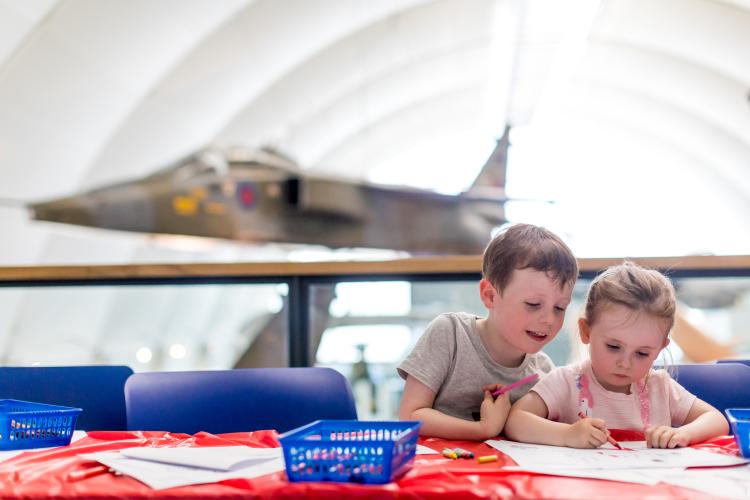Aviation meets innovation with a £2.4m investment to support net zero

Royal Air Force
Royal Air Force propels decarbonisation with low carbon upgrades to historic hangars
The Royal Air Force Museum, that celebrates over a century of RAF history, is now blending its legacy of innovation with a bold commitment to sustainability.
As part of its Strategy 2030, the museum is working towards achieving net zero carbon emissions by 2030, demonstrating that even the most historic sites can lead the charge in decarbonisation.
Our Salix team had the opportunity to witness the ongoing transformation at the museum's London site. The museum is undergoing a significant upgrade, funded by Phase 3c of the Public Sector Decarbonisation Scheme from the Department for Energy Security and Net Zero. This £2.4 million investment is driving the replacement of aging heating systems and introducing state-of-the-art, low-carbon technologies, ensuring that this landmark institution remains at the forefront of both history and sustainability.
Karen Whitting, director of content and programmes at the museum, said: “We are deeply grateful to the Public Sector Decarbonisation Scheme for the funding which allows this invaluable investment in the RAF Museum.
“This support not only strengthens our ability to deliver meaningful and inspiring experiences for our visitors but also plays a vital role in advancing our sustainability efforts.
“By working together, we can ensure the museum continues to thrive as a space where history and innovation meet, all while reducing our environmental impact for the benefit of future generations.”

Photo credit: RAF
Preserving heritage and driving innovation
The Royal Air Force Museum’s historic Hangars three and four, dating back to 1917, are at the heart of this transformation.
We had the chance to explore these grand structures, which once served as operational spaces for the Royal Air Force during its formative years. Today, they house some of the most iconic RAF aircraft from the First and Second World Wars.
As we stood within these large hangars, we couldn’t help but marvel at the sheer scale and historical significance of the space. The towering beams and the sweeping open interiors were awe-inspiring, evoking the feeling of being immersed in history. Yet, in the same breath, we could also imagine the future of this space, transformed by cutting-edge sustainability technologies.
The hangars, steeped in history, are now undergoing a modernisation that will ensure their longevity in the face of climate change. During our visit, we were able to see the outdated gas-fired boilers, which have reached the end of their life, soon to be replaced by highly efficient air source heat pumps.
The air source heat pumps will extract heat from the outside air, providing a reliable and low-carbon heating solution for these expansive hangars that house rare aircraft and serve as gallery spaces for museum visitors.
The museum is also implementing a photovoltaic (PV) solar system, which will generate electricity on-site and further reduce the museum’s reliance on fossil fuels. Other upgrades include insulation to help reduce possible heat loss. Together, these upgrades are forecast to save the museum around 345 tonnes of carbon and £52,000 annually.
Giovanni Canino, head of estates and sustainability at the museum, said: “It’s thrilling to see such a historic site being transformed for the future. We’re integrating the latest technologies, like air source heat pumps and solar PV, while preserving the integrity of the museum’s heritage. It’s a balance between honouring the past and shaping the future.”

Photo credit: RAF
Empowering education through sustainability
In addition to its environmental efforts, the museum is deeply committed to educating the next generation about sustainability. Through hands-on learning experiences and interactive sessions, it teaches visitors, particularly schoolchildren, about the importance of reducing carbon emissions and incorporating sustainable practices into everyday life.
We had the chance to witness schoolchildren eagerly engaging with the exhibits, asking insightful questions, and learning about the RAF’s rich history.
Karen said: “Our role as a museum extends beyond showcasing history, We want to make visitors part of the process of understanding sustainability. We aim to help them see how these changes fit into the broader context of the Museum’s legacy and encourage them to think about their own role in shaping a sustainable future.”
The visit to the RAF Museum held special significance for our own Salix team member Elan Parry-Lowther.
Elan said: “It was incredibly moving for me to visit the museum and see how it is embracing sustainability.
“My grandfather served with the Royal Air Force, and it’s inspiring to see the museum, which honours the legacy of so many brave individuals, now playing a leading role in protecting the future of our planet. The work being done here truly reflects the RAF’s commitment to innovation, both past and present.”

Photo credit: RAF
A sustainable legacy
Beyond the heating system and solar PV installation, the museum is also pioneering other sustainability initiatives.
During our visit, we learnt about its sustainable drainage system, or ‘swale,’ which helps manage excess rainwater and conserve water in the local ecosystem. These initiatives, alongside the new technologies, are part of a broader effort to reduce emissions and improve environmental performance across the site.
The museum is also focusing on reducing Scope 3 emissions, such as cutting delivery frequencies and choosing electric vehicles for transportation. These efforts are part of the museum’s larger goal to achieve a silver carbon literacy award and inspire others to adopt similar practices.
Scope 3 emissions are indirect greenhouse gas emissions from a company’s value chain, including activities like transportation, employee travel, and waste disposal. For the museum, reducing these emissions involves working with suppliers, using electric vehicles, and optimizing delivery logistics. Tackling Scope 3 emissions is key to achieving broader sustainability goals and reducing the overall carbon footprint.
Giovanni added: “We’re passionate about striking the right balance between respecting the heritage of the site and embracing the changes needed to make it more sustainable. Our staff are heavily invested in this vision and passionate about contributing in whichever way they can.”
A bright, sustainable future
Moving forward, the museum has decarbonisation plans for its Midlands site, which serves as the main training facility for the Royal Air Force since the Second World War. This bid is focused on upgrading 1930s hangars, with plans to introduce cladding, photovoltaic solar panels, and heat pumps to improve energy efficiency.
Additionally, a new learning centre will be created, open for talks and tours, and objects from the museum’s collection will be shared with schools and care homes as part of its ongoing commitment to community engagement. The hope is to begin detailed design and construction in May 2026, with the facility expected to open in 2027.
Through these initiatives, the museum continues to demonstrate that preserving the past and innovating for the future can go hand-in-hand, offering both a legacy of excellence and a forward-looking approach to environmental responsibility. We’re grateful to have had the opportunity to witness the foundations of this inspiring project firsthand, and we’re excited to see how it continues to unfold.




